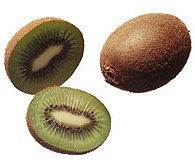Kiwi Fruit
http://www.100md.com
《e Natural Health Center》
 |
 |
 |
 |
Fruits
Kiwi Fruit
Latin:
Actinidia chinensis
Origin:
The edible fruit of the vine Actinidia chinensis Planch., or Actinidia deliciosa (A.Chev.) C.F.Liang. & A.R.Ferguson., of the family Actinidiaceae. The plant is native to China and Taiwan, with the earliest recorded planting dated 1900, by foreigners living in the Yangtze Valley, China. By 1910 kiwi plants were being grown in North Island of New Zealand and in California. New Zealand monopolised the market till the late 1960's when California started growing it on a large scale. Since the 1980's other countries such as Chile and Australia have also entered the market. Kiwi is now grown also in France, Italy, Spain, Israel, South Africa, and Russia.
, 百拇医药
Actinidia chinensis was once mainly known as Chinese Gooseberry but through marketing by New Zealand fruit growers, it is now known as kiwi, named after a bird native there, which is actually quite a good name because its furry, round shape is reminiscent of the appearance of a Kiwi. The name change also reflects its history because it is indigenous to southeastern China but it was the New Zealanders that developed cultivars and marketed it.
The decidious climber grows to about 9 m at a medium rate. It is in flower from July to August. The scented flowers are dioecious (individual flowers are either male or female, but only one sex is to be found on any one plant so both male and female plants must be grown if seed is required) and are pollinated by bees and insects. The plant is not self-fertile. It can grow in semi-shade (light woodland) or no shade, and requires moist soil.
, http://www.100md.com
The egg-shaped kiwi fruit can be up to 8 cm long, it is very juicy when fully ripe and has a refreshing, acid flavor, has a furry brownish green skin and firm, translucent green flesh with a number of small, edible purple-black seeds at the centre. The fruit is sweeter near its white center and small edible seeds. The fruit ripens in November and can store for 3 - 4 months. Yields of 8 - 30 tonnes per hectare are possible.
Although there are approximately ten varieties of kiwi fruit, the ones found in the market are generally the large, egg-sized, sweet kiwi.
, 百拇医药
Kiwi fruit can survive for long periods after picking. After reaching full size, the fruit can take as long as two months to ripen but this can be speeded up by exposing them to ethylene gas which in a household situation can be achieved by keeping them enclosed with bananas or apples. They can be kept 4-6 months in cold storage. These long storage periods are particularly favorable to New Zealand growers because they are so far from the European and American markets.
, 百拇医药
Kiwis are available April through December, peaking June to October.
Also called Chinese Gooseberry, Kiwi, and Kiwifruit.
Properties:
Sweet and sour in flavor, cold in nature, it is related to the channels of the kidney and stomach.
Functions:
Quenches thirst, relieves lin syndrome (urinary problem).
, 百拇医药
Applications:
Kiwi fruit is used for mental depression, diabetes, jaundice, urinary stones and hemorrhoids.
Two medical professors in Taiwan proposed in a conference in April 2003 that consuming 2 kiwi fruits a day, as well as wearing mask, would be a good practice for preventing Severe Acute Respiratory Syndrome (SARS) or atypical pneumonia. However, the medical profession has not put out any formal publication as to the therapeutic efficiency of kiwi fruit on SARS.
, 百拇医药
Dosage and Administration:
Once the fuzzy peel is removed, the entire fruit can be eaten. Slice the fruit to make beautiful garnishes on cakes, cocktails, cheese plates, or breakfast cereals. For a delicious, vitamin C-packed treat, cut the fruit into chunks, mix with strawberries and orange pieces, let sit for an hour to blend juices, stir, and serve.
Cooking kiwi fruit is not recommended, although they can be blended into sauces or soups.
, http://www.100md.com
Choose semi-firm, unblemished fruit with uniform skin. Kiwis sweeten with age but should be consumed before they become mushy; they will ferment if left too long. Refrigerate when soft.
Cautions on Use:
A few preliminary reports suggest that food allergy may cause some cases of acute pancreatitis. Food allergies identified in these cases included kiwi fruit. No research has investigated the possible role of food allergy in other causes of pancreatic insufficiency.
, http://www.100md.com
Reference Materials:
Toxic or Side Effects:
Modern Researches:
Kiwi fruit is rich in vitamin C. Fresh fruits contain 100 - 420 mg vitamin C per 100 g, exceeding those of any citrus fruit; and 8 - 14 percent carbohydrate. Acidity is 1 - 2 percent, mainly citric acid.
The fruits, stems and roots are diuretic, febrifuge and sedative. They are used in the treatment of stones in the urinary tract, rheumatoid arthralgia, cancers of the liver and oesophagus.
, http://www.100md.com
The fruit has a proteolytic enzyme that has meat tenderizer type properties.
Kiwi leaves are a famine food.
Paper is made from the bark of kiwi plant.
If the bark is removed in one piece from near the root and placed in hot ashes, it becomes very hard and can be used as a tube for a pencil., http://www.100md.com